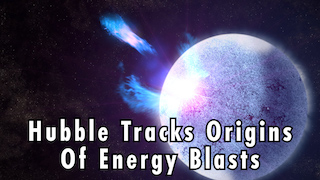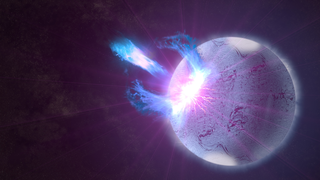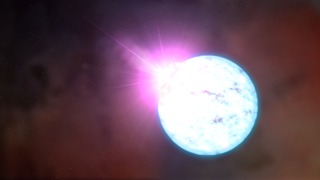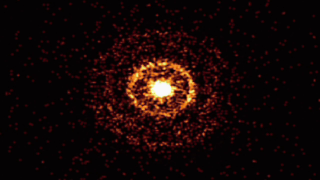Universe
ID: 13751
On April 28, a supermagnetized stellar remnant known as a magnetar blasted out a simultaneous mix of X-ray and radio signals never observed before. The flare-up included the first fast radio burst (FRB) ever seen from within our Milky Way galaxy and shows that magnetars can produce these mysterious and powerful radio blasts previously only seen in other galaxies.
A magnetar is a type of isolated neutron star, the crushed, city-size remains of a star many times more massive than our Sun. What makes a magnetar so special is its intense magnetic field. The field can be 10 trillion times stronger than a refrigerator magnet's and up to a thousand times stronger than a typical neutron star's. This represents an enormous storehouse of energy that astronomers suspect powers magnetar outbursts.
The X-ray portion of the synchronous bursts was detected by several satellites, including NASA's Wind mission.
The radio component was discovered by the Canadian Hydrogen Intensity Mapping Experiment (CHIME), a radio telescope located at Dominion Radio Astrophysical Observatory in British Columbia and led by several Canadian universities. It was also detected by the NASA-funded Survey for Transient Astronomical Radio Emission 2 (STARE2), a trio of detectors in California and Utah operated by Caltech and NASA’s Jet Propulsion Laboratory in Southern California. The STARE2 data showed that the burst's energy was comparable to FRBs.
By the time these bursts occurred, astronomers had already been monitoring their source, a magnetar named SGR 1935+2154, for more than half a day using NASA's Neil Gehrels Swift Observatory, Fermi Gamma-ray Space Telescope, and the Neutron star Interior Composition Explorer (NICER) X-ray telescope mounted atop the International Space Station.
About 13 hours later, when the magnetar was out of view for Swift, Fermi and NICER, a special X-ray burst erupted. The blast was seen by the European Space Agency’s INTEGRAL mission, the China National Space Administration’s Huiyan X-ray satellite, and the Russian Konus instrument on Wind. As the half-second-long X-ray burst flared, CHIME and STARE2 detected the radio burst, which lasted only a thousandth of a second.
Taken together, the observations strongly suggest that the magnetar produced the Milky Way galaxy's equivalent of an FRB, which means magnetars in other galaxies likely produce at least some of these signals.
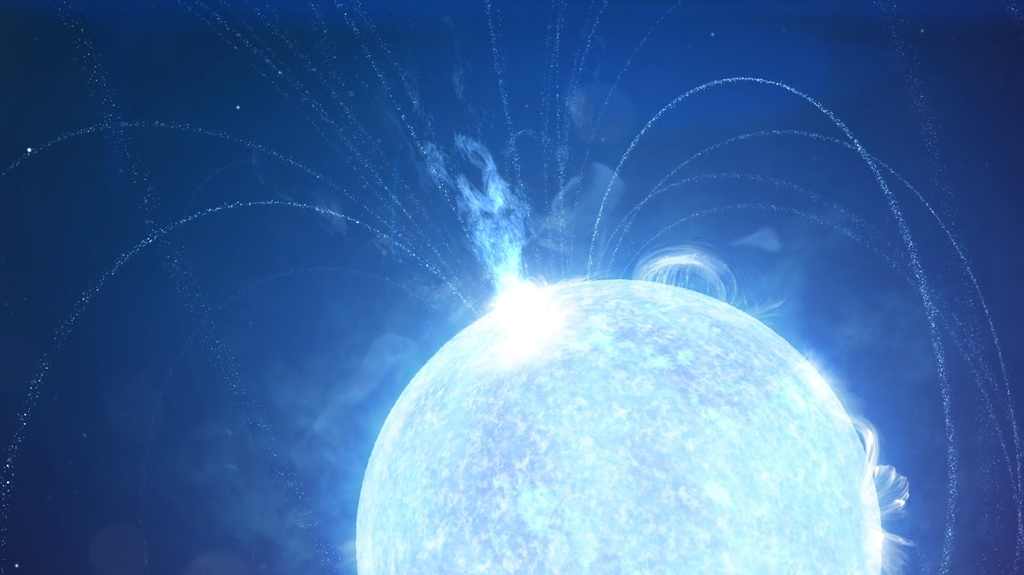
NASA Missions Team Up to Study Unique Magnetar Outburst
A magnetar is a type of isolated neutron star, the crushed, city-size remains of a star many times more massive than our Sun. What makes a magnetar so special is its intense magnetic field. The field can be 10 trillion times stronger than a refrigerator magnet's and up to a thousand times stronger than a typical neutron star's. This represents an enormous storehouse of energy that astronomers suspect powers magnetar outbursts.
The X-ray portion of the synchronous bursts was detected by several satellites, including NASA's Wind mission.
The radio component was discovered by the Canadian Hydrogen Intensity Mapping Experiment (CHIME), a radio telescope located at Dominion Radio Astrophysical Observatory in British Columbia and led by several Canadian universities. It was also detected by the NASA-funded Survey for Transient Astronomical Radio Emission 2 (STARE2), a trio of detectors in California and Utah operated by Caltech and NASA’s Jet Propulsion Laboratory in Southern California. The STARE2 data showed that the burst's energy was comparable to FRBs.
By the time these bursts occurred, astronomers had already been monitoring their source, a magnetar named SGR 1935+2154, for more than half a day using NASA's Neil Gehrels Swift Observatory, Fermi Gamma-ray Space Telescope, and the Neutron star Interior Composition Explorer (NICER) X-ray telescope mounted atop the International Space Station.
About 13 hours later, when the magnetar was out of view for Swift, Fermi and NICER, a special X-ray burst erupted. The blast was seen by the European Space Agency’s INTEGRAL mission, the China National Space Administration’s Huiyan X-ray satellite, and the Russian Konus instrument on Wind. As the half-second-long X-ray burst flared, CHIME and STARE2 detected the radio burst, which lasted only a thousandth of a second.
Taken together, the observations strongly suggest that the magnetar produced the Milky Way galaxy's equivalent of an FRB, which means magnetars in other galaxies likely produce at least some of these signals.

Related
For More Information
Credits
Scott Wiessinger (USRA): Producer
Chris Smith (USRA): Producer
Chris Smith (USRA): Lead Animator
Francis Reddy (University of Maryland College Park): Lead Science Writer
Scott Wiessinger (USRA): Narrator
Scott Wiessinger (USRA): Editor
Scott Wiessinger (USRA): Animator
Zaven Arzoumanian (NASA/GSFC): Scientist
Chris Smith (USRA): Producer
Chris Smith (USRA): Lead Animator
Francis Reddy (University of Maryland College Park): Lead Science Writer
Scott Wiessinger (USRA): Narrator
Scott Wiessinger (USRA): Editor
Scott Wiessinger (USRA): Animator
Zaven Arzoumanian (NASA/GSFC): Scientist
Please give credit for this item to:
NASA's Goddard Space Flight Center. However, individual items should be credited as indicated above.
NASA's Goddard Space Flight Center. However, individual items should be credited as indicated above.
Science Paper:
https://www.nature.com/articles/s41586-020-2863-y; https://www.nature.com/articles/s41586-020-2872-x
Short URL to share this page:
https://svs.gsfc.nasa.gov/13751
Missions:
Fermi Gamma-ray Space Telescope
Swift
Neutron star Interior Composition Explorer (NICER)
This item is part of these series:
Narrated Movies
Astrophysics Animations
Astrophysics Features
Keywords:
SVS >> HDTV
SVS >> Music
SVS >> Neutron Star
SVS >> X-ray
SVS >> Astrophysics
SVS >> Edited Feature
SVS >> Magnetar
DLESE >> Narrated
SVS >> Radio Telescope
NASA Science >> Universe
SVS >> Flare
https://www.nature.com/articles/s41586-020-2863-y; https://www.nature.com/articles/s41586-020-2872-x
Short URL to share this page:
https://svs.gsfc.nasa.gov/13751
Missions:
Fermi Gamma-ray Space Telescope
Swift
Neutron star Interior Composition Explorer (NICER)
This item is part of these series:
Narrated Movies
Astrophysics Animations
Astrophysics Features
Keywords:
SVS >> HDTV
SVS >> Music
SVS >> Neutron Star
SVS >> X-ray
SVS >> Astrophysics
SVS >> Edited Feature
SVS >> Magnetar
DLESE >> Narrated
SVS >> Radio Telescope
NASA Science >> Universe
SVS >> Flare
